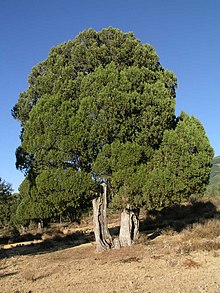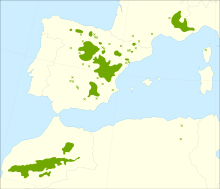| Juniperus thurifera | |
|---|---|

| |
| Juniperus thurifera at Prádena de la Sierra (Segovia, Spain) | |
| Conservation status | |
 Least Concern (IUCN 3.1) | |
| Scientific classification | |
| Kingdom: | Plantae |
| Clade: | Tracheophytes |
| Clade: | Gymnospermae |
| Division: | Pinophyta |
| Class: | Pinopsida |
| Order: | Cupressales |
| Family: | Cupressaceae |
| Genus: | Juniperus |
| Section: | Juniperus sect. Sabina |
| Species: | J. thurifera |
| Binomial name | |
| Juniperus thurifera L. | |

| |
| Natural range | |
| Synonyms | |
| |
Juniperus thurifera (Spanish juniper) is a species of juniper native to the mountains of the western Mediterranean region, from southern France (including Corsica) across eastern and central Spain to Morocco and locally in northern Algeria.
The name thurifera comes from the Latin turifer, "producer/bearer of incense".
It is a large shrub or tree reaching 6–20 metres (20–66 feet) tall, with a trunk up to 2 m (6+1⁄2 ft) in diameter and a broadly conical to rounded or irregular crown. The foliage is strongly aromatic with a spicy-resinous scent. The leaves are of two forms: juvenile needle-like leaves 8–10 millimetres (5⁄16–3⁄8 inch) long on seedlings and irregularly on adult plants, and adult-scale leaves 0.6–3 mm long on older plants; they are arranged in decussate opposite pairs. It is dioecious with separate male and female plants. The cones are berry-like, 7–12 mm in diameter, blue-black with a whitish waxy bloom, and contain 1–4 seeds; they are mature in about 18 months. The male cones are 3–4 mm long, and shed their pollen in early spring.
There are two varieties, regarded as distinct by some authors, but not by others:
- Juniperus thurifera var. thurifera. Spain, France. Mature cones 8–12 mm, with 2–4 seeds.
- Juniperus thurifera var. africana Maire. Morocco, Algeria. Mature cones 7–8 mm, with 1–2 seeds.
Overall, the species is not considered threatened with healthy population in Spain; however, the African population is threatened by severe overgrazing, mainly by goats, and is listed as Endangered.
The largest Spanish Juniper forest in Europe is in the Sierra de Solorio.

References
- ^ Farjon, A. (2013). "Juniperus thurifera". IUCN Red List of Threatened Species. 2013: e.T42255A2967372. doi:10.2305/IUCN.UK.2013-1.RLTS.T42255A2967372.en. Retrieved 13 November 2021.
- The Plant List: A Working List of All Plant Species, retrieved 11 February 2017
- ^ Adams, R. P. (2004). Junipers of the World. Trafford. ISBN 1-4120-4250-X
- ^ Farjon, A. (2005). Monograph of Cupressaceae and Sciadopitys. Royal Botanic Gardens, Kew. ISBN 1-84246-068-4
- ^ Earle, Christopher J., ed. (2018). "Juniperus thurifera". The Gymnosperm Database.
- ^ Ecology and conservation of Juniperus thurifera Juniperus thurifera website
- El Sabinar más extenso de Europa
Further reading
- Gastón González, A.; et al. (2016). "Juniperus thurifera in Europe: distribution, habitat, usage and threats" (PDF). European Atlas of Forest Tree Species. European Commission.
| Taxon identifiers | |
|---|---|
| Juniperus thurifera |
|